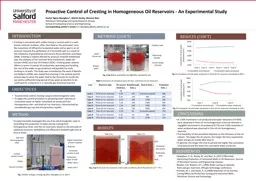

Hector Ngozi Akangbou Martin Burby Ghasem Nasr Petroleum Technology and Spray Research Groups School of Computing Science and Engineering Corresponding authors email hnakangbouedusalfordacuk ID: 627097
Download Presentation The PPT/PDF document "Proactive Control of Cresting in Homogen..." is the property of its rightful owner. Permission is granted to download and print the materials on this web site for personal, non-commercial use only, and to display it on your personal computer provided you do not modify the materials and that you retain all copyright notices contained in the materials. By downloading content from our website, you accept the terms of this agreement.
Slide1
Proactive Control of Cresting in Homogeneous Oil Reservoirs - An Experimental Study
Hector Ngozi Akangbou*, Martin Burby, Ghasem NasrPetroleum Technology and Spray Research GroupsSchool of Computing Science and EngineeringCorresponding author’s email: h.n.akangbou@edu.salford.ac.uk
INTRODUCTION
Cresting
in horizontal wells unlike coning in vertical wells is a well-known reservoir problem, often described as the protruded, crest-like movement of effluent(s) (unwanted water and or gas) in an oil reservoir towards the perforation of a horizontal well as a result of the imbalance of gravitational and viscous forces (Kromah and Dawe, 2008). Cresting is majorly affected by pressure drop/Oil withdrawal rate, the intensity of the reservoir drive mechanism, water-Oil-Contact (WOC) and Gas-Oil-Contact (GOC). Cresting poses adverse effects in terms of overall oil productivity, operating and handling the cost of the water or gas produced and possibly the early shutting-in of wells. This study was motivated by the work of Beattie and Roberts (1996), who stated that shutting-in the vertical well for several days to allow the water level in the fractures to recede did not yield a sufficiently long period of low water production to be continued for a long term in a naturally gas fractured reservoir.
objectives
To proactively control cresting using an electromagnetic valve.
To apply the control procedure in producing lower volumes of cumulative water at higher cumulative oil produced from homogeneous thin- and thick-oil rim reservoirs, characterized by considerable gas cap and strong bottom aquifer.
method
To experimentally investigate the use of
an electromagnetic valve in controlling the production of water during cresting from homogeneous thick- and thin-oil reservoirs, based on the principle of capillarity (reservoir wettability) and effluent(s) breakthrough time at shut-in times.
results
Results (CON’T)
conclusions
A
3.56%
increment
in
oil produced and water reduction of 9.96% were observed in thick-oil rim homogeneous reservoir whereas a negligible increment in oil produced (0.7%) and 1.03% reduction in water produced was observed in thin-oil rim homogeneous reservoir. The feasibility of this procedure depends on the thickness of the oil column. The larger the oil column, the longer the time required for water and gas to recede after shut-in. In general, the longer the shut-in periods the higher the cumulative oil produced and the lower the cumulative water produced.
Fig. 5 Cumulative oil and water produced in thin-oil rim reservoir simulated at 210 s
Fig. 1
Water and gas cresting rig (after Akangbou et al. 2017)
Fig. 4 Cumulative oil and water produced in thick-oil rim reservoir simulated at 495 s
Case Reservoir typeOil column thickness, mBreakthrough time, sShut-in time, sProduction time, sCase 1Thick-oil rim reservoir0.341400 (uninterrupted)495Case 2Thick-oil rim reservoir 0.34 140960495Case 3Thick-oil rim reservoir 0.34 1402700495Case 4Thick-oil rim reservoir 0.34 1405400495Case 5Thick-oil rim reservoir 0.34 1407200495Case 6 Thick-oil rim reservoir 0.34 1409000495Case 7Thin-oil rim reservoir0.18630 (uninterrupted)210Case 8Thin-oil rim reservoir 0.18 63960210Case 9 Thin-oil rim reservoir0.18 632700210
Fig. 3 (a) A thick-oil rim reservoir under static conditions (b) A thick-oil rim at T = 70 s
Methods (CON’T)
Fig. 2 (a) Before wettability test (b) After wettability test
References
Akangbou
, H. N., Burby, M. and Nasr, G. (2017) Effectively Optimizing Production of Horizontal Wells in Oil Reservoirs. Journal of Petroleum Science and Engineering, Elsevier. Beattie, D.R, Roberts, B.E. (1996) Water coning in naturally fractured gas reservoirs. SPE gas technology conference.Kromah, M. J. and Dawe, R. A.(2008) Reduction of Oil and Gas Coning Effects by Production Cycling and Horizontal Wells. Petroleum Science and Technology.
Table 1
Summary of simulated cases for thin- and thick-oil
rim reservoirs